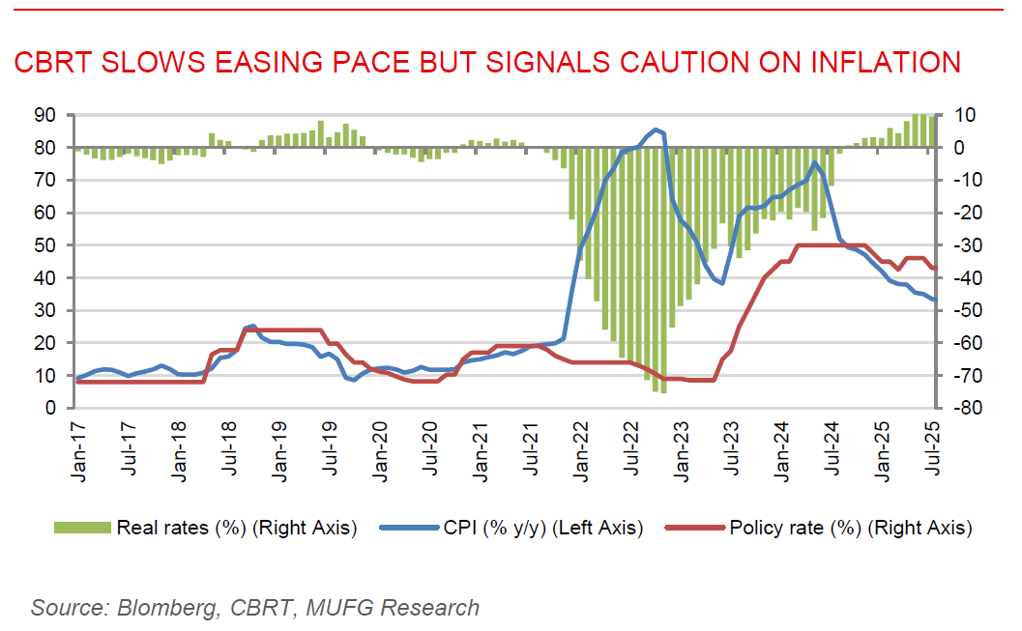To read the full report, please download the PDF above.
Middle East Daily
SOOJIN KIM
Research Analyst
DIFC Branch – Dubai
T: +44(4)387 5031
E: soojin.kim@ae.mufg.jp
MUFG Bank, Ltd. and MUFG Securities plc
A member of MUFG, a global financial group
Middle East Daily
COMMODITIES / ENERGY
Oil slides as IEA surplus forecast weighs against geopolitical risks. Oil prices fell further, with Brent trading near USD66/b and WTI around USD62/b, as markets absorbed the International Energy Agency’s projection of a record supply glut in 2026, which overshadowed geopolitical tensions spanning from the Middle East to Europe. The decline comes after OPEC+’s weakened decision to continue adding back idled barrels in October, albeit at a slower pace than recent months. The IEA’s warning contrasted with OPEC’s own report projecting continued supply deficits, highlighting a sharp divide in outlooks. Despite geopolitical tensions, crude futures are still more than 10% lower YTD, with the US Energy Information Administration warning the glut is already underway, as inventories swell this quarter despite intermittent geopolitical spikes.
Gold extends weekly gains on Fed cut bets and ETF inflows. Gold is set for its fourth straight weekly gain, climbing toward USD3,650/oz and rising nearly 2% this week after hitting a record earlier, buoyed by expectations the Fed will cut rates. Softer US labour data and an in-line August inflation print have given policymakers room to ease, while a weaker dollar and falling Treasury yields further support gold. Gold has surged 39% this year, outpacing equities, with demand reinforced by central bank purchases, geopolitical uncertainty, and inflows into ETFS, which expanded by almost 25 tons this week. Silver also rallied above USD42/oz, its strongest since 2011. The rally coincides with political pressure on Fed independence, as President Trump renewed efforts to remove Governor Lisa Cook ahead of the September Fed meeting. Meanwhile, Asian demand remains robust, with Thai households expected to increase gold purchases for a fifth year, complicating local currency management.
MIDDLE EAST - MACRO / MARKETS
CBRT slows easing pace but signals caution on inflation. The Central Bank of Turkey (CBRT) cut its one-week repo rate by 250bps to 40.50%, a larger than expected move but slower than July’s 300bps cut, signalling caution as it balances disinflation goals with inflation risks. The accompanying statement emphasised the importance of intermediate disinflation targets, particularly the 16% goal for next year, and signalled readiness to tighten policy if significant risks to the outlook emerge, replacing earlier guidance with stronger language on inflation vigilance. While the bank highlighted a slowdown in underlying price trends in August, it also acknowledged continued pressure from food and services, and despite strong than expected Q2 GDP, it judged domestic demand as being at disinflationary levels, consistent with a softer growth outlook. The decision suggests that further easing will proceed in smaller steps, keeping the end-2025 policy rate around 36%. Looking ahead, inflation is projected to fall to 30% by end-2025, while the policy rate is expected to decline to 26% over the same horizon, ensuring positive real rates. However, the trajectory will hinge on external balances, reserve dynamics, and political developments that could complicate the CBRT’s cautious disinflation path.
Saudi oil exports set to surge as local demand eases. Saudi Arabia’s oil exports are projected to rise by about 500,000b/d in September, driven by higher production and a sharp drop in domestic demand following peak summer consumption. The Kingdom’s crude use for power generation surged above 900,000b/d in August, the highest since 2009, but is expected to fall by a third this month and below 400,000b/d in October, freeing more supply for global markets. This increase comes as Saudi Arabia leads OPEC+ in restoring previously curbed output, even as the International Energy Agency warn of a looming glut, with forecasts of a record surplus by 2026. Nonetheless, Saudi officials remain bullish, with Aramco CEO Amin Nasser forecasting global demand growth of 2mb/d in the second half of 2025 and highlighting the forthcoming Jafurah gas projects, which will gradually displace crude use domestically and free up an additional 350,000b/d for export by 2030.
Saudi Arabia grants crude supply to support Syria’s recovery. Saudi Arabia agreed to supply 1.65 million barrels of crude to Syria under a new memorandum of understanding signed between the Saudi Fund for Development and Syria’s Ministry of Energy, aiming to boost refinery operations and help ease the country’s severe energy shortages. The grant is positioned as part of Saudi Arabia’s broader efforts to support Syrians’ living conditions as the nation emerges from nearly 14 years of civil war that devastated infrastructure, displaced millions, and left the economy crippled under the weight of conflict and sanctions. While Syria has recently resumed limited oil exports, including 600,000 barrels shipped earlier this month from Tartous, domestic supply remains insufficient, with most households sill enduring only a few hours of power each day unless they can afford costly alternatives like generators or solar panels. The Saudi move highlights growing regional investment interest in Syria’s reconstruction, particularly in the energy sector, as the country seeks to rebuild its economy despite persistent hardship on the ground.

